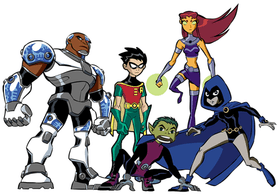Anime-influenced animation

Anime-influenced animation, amerime refers to non-Japanese works of animation that emulate certain aspects of the visual style of Japanese anime.[1] With the rise of anime's popularity it has become an integral part of animation produced in the Western world.
Background
Generally, the term anime refers to a style of animation originating from Japan. As Japanese anime became increasingly popular, Western animation studios began implementing some visual stylizations typical in anime—such as exaggerated facial expressions and "super deformed" versions of characters. In particular, works like The Batman, Teen Titans, and Batman Beyond[2] displayed some characteristics of anime. Particularly for Batman Beyond, some of its production processes were outsourced to Japan.[2]
United States


The influence of Japanese anime on Western animation can be seen as far back as the 1980s, when animations such as Transformers were inspired by mecha anime (although the original Transformers anime was Japanese-animated, and its accompanying toy-line were re-issues of Japanese toys, so this may not count as an example). The influence of mecha anime on the Transformers franchise continues today, with the creators of Transformers Animated citing relatively recent Gainax productions, specifically Diebuster and Gurren Lagann, as major influences.[3]
The advent of Japanese anime stylizations appearing in Western animation questioned the established meaning of "anime;"[1] there are several Western animators who collaborated with Japanese anime creators while producing Western animation. For example, production on The Animatrix began when the Wachowskis visited some of the creators of the anime films that had been strong influences on their work, and decided to collaborate with them.[4] The collaboration between Western and Japanese animators dates back to the early 1980s, such as the Dungeons & Dragons animated series being a co-production between Marvel Animation and Toei Animation.[5] A number of other American animations of the 1980s and 1990s were outsourced to anime studios, most notably TMS Entertainment, which animated popular television productions such as DuckTales, Batman: The Animated Series, Animaniacs, and Spider-Man.
Avatar: The Last Airbender, and its sequel series The Legend of Korra are other examples of Western animation influenced by Japanese anime. They are considered anime by some fans because both their plots and style have similarities to ones normally seen in an anime.[6] Avatar creators Bryan Konietzko and Michael Dante DiMartino confirmed a particular Japanese anime influence in a magazine interview; that of "Hayao Miyazaki, especially Spirited Away and Princess Mononoke"[7] as well as My Neighbor Totoro.[8] Other studios from which inspiration was drawn include Studio 4°C, Production I.G, and Studio Ghibli.[9]
The Boondocks is a successful and controversial American animated series [10] based on the comic strip of the same name. Unlike the shows mentioned earlier, The Boondocks is aimed at adults and airs on Adult Swim, a mature-oriented TV network that shares channel space with Cartoon Network. Aaron McGruder, the creator of both the comic and the animation says in an interview that the series was influenced by his love of Japanese anime and manga. He cites Cowboy Bebop and Samurai Champloo as sources of inspiration for the series' fight scenes. The opening sequence of season 1 is also remarkably similar to that of Samurai Champloo. Some of the humor is based on the characters' anime-style movements. The second season features segments animated by Japanese animation studio Madhouse. As a result, the second season of the series has more detailed animation as well as minor updates for most of the character designs.
Europe and Canada
Many French and Canadian animation have also been influenced by Japanese anime, such as the Totally Spies! series.[11] The producers of the French anime Code Lyoko, one of most successful works of European anime, explicitly stated in their introductory document that they were: "Influenced by the poetry and the visual impact of Japanese animation, the series proposes a graphic universe that's particularly original and strong."[12] In 2007, the Canadian anime-style animated short Flutter became the first work from a non-Asian nation to win the Open Entries Grand Prize at the Tokyo Anime Awards.[13]
Latin America
The animations of this genus are almost scarce in this region. However, a number of Brazilian comics of Holy Avenger with strong features inspired by the manga were being produced, but ended up being canceled due to lack of experienced animators. Also various other Brazilian animated series to arrive as planned Dogmons![14] and XDragoon (the latter became a webcomic), but then canceled after the first episode. An animated version of Monica Teen will debut on Cartoon Network.
See also
Notes
- 1 2 "What is anime?". ANN. 2002-07-26. Archived from the original on 20 August 2007. Retrieved 2007-08-18.
- 1 2 "Ms. Answerman: The Internet Question Massacre". Rebecca Bundy, ANN. 2003-10-17. Retrieved 2007-08-09.
- ↑ "Preview of upcoming Transformers Animated characters". Transformers Animated. April 30, 2008. Retrieved 2010-02-09.
- ↑ "What is Animatrix?" feature on The Matrix Revisited DVD.
- ↑ Dungeons & Dragons at the Internet Movie Database
- ↑ "Avatar: The Last Airbender Article". Animation World Magazine. 2005-02-18. Archived from the original on 17 December 2006. Retrieved 2006-12-16.
- ↑ ""In Their Elements." (September 2006) Nick Mag Presents, p. 6".
- ↑ Bryan Konietzko and Michael Dante DiMartino (2006-09-19). Book 1: Water, Box Set (DVD).
- ↑ "Anime Insider: December 2006". Retrieved 2007-03-20.
- ↑ Robinson, Bryan (2005-11-05). "'The Boondocks': Not the N&#@$%a Show". ABC. Retrieved 2014-10-29.
- ↑ "Answerman: Saturday Surprise". Answerman. Anime News Network. 2002-07-13. Retrieved 2008-08-09.
- ↑ Promotional document for Garage Kids PDF (798 KB) Page 2, paragraph 2
- ↑ "Shia wins top prize". Regina Leader-Post. 24 March 2007. Retrieved 15 January 2011.
- ↑ pt:Dogmons!
References
- Kime, Chad (1997). "American Anime: Blend or Bastardization?". EX 3.3. EX.org. Archived from the original on 1 September 2006. Retrieved 2006-07-29.
- Khan, Ridwan (July 2003). "American Anime - Is it Possible?". Animefringe.com. Archived from the original on 15 June 2006. Retrieved 2006-07-29.